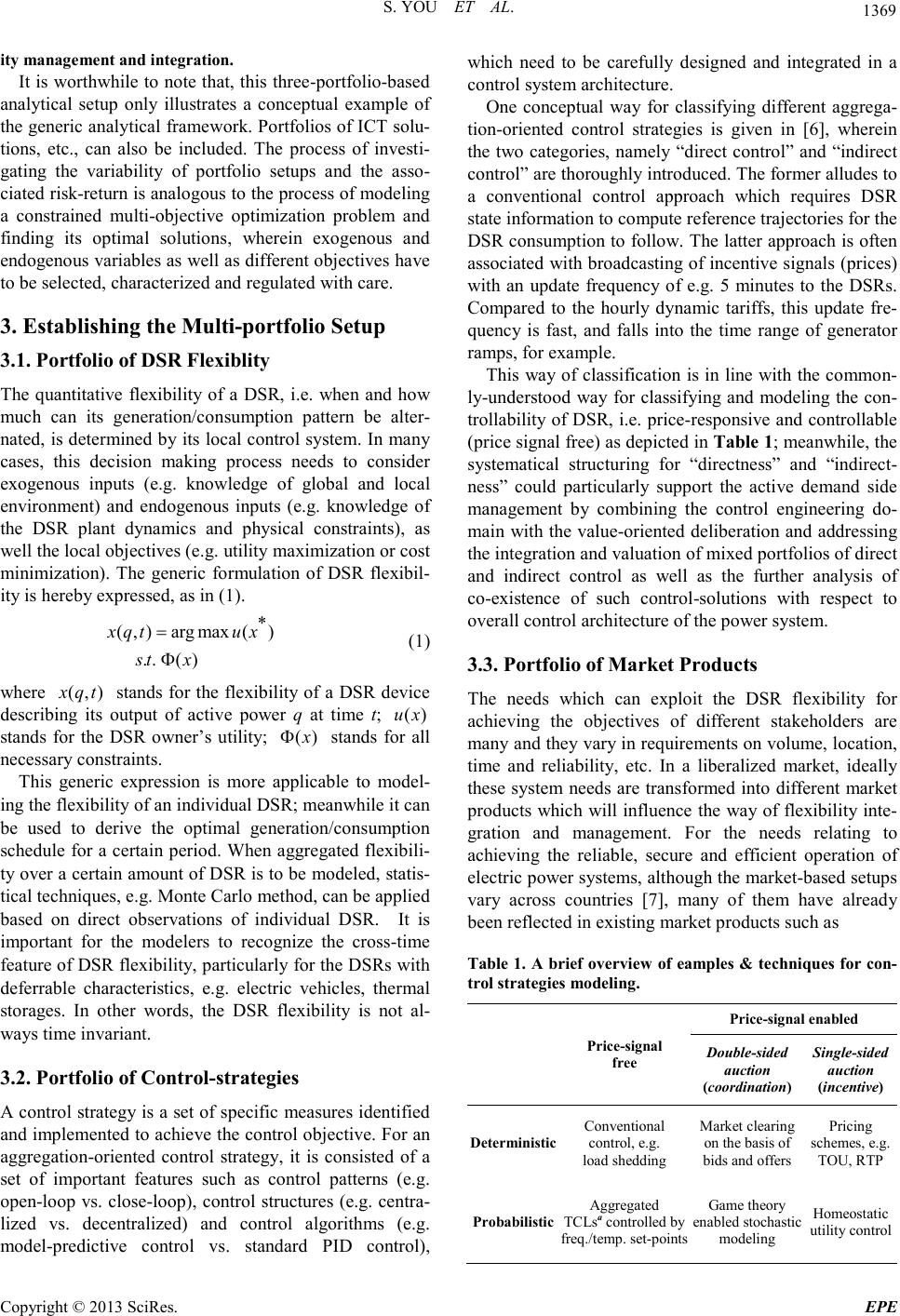
S. YOU ET AL.
Copyright © 2013 S ciRes. EPE
ity management and integration.
It is wort hwhile to note that, t his three-portfolio -based
analytical setup only illustrates a conceptual example of
the generic analytical framewor k. Portfolios of ICT solu-
tions, etc., can also be included. The process of investi-
gating the variability of portfolio setups and the asso-
ciated risk-return is analogous to the process of modeling
a constrained multi-objective optimization problem and
finding its optimal solutions, wherein exogenous and
endogenous variables as well as different objectives have
to be selected, characterized and regulated with care.
3. Establishing the Multi-portfolio Setup
3.1. Por t folio o f DSR Fl ex ib l ity
The quantitative flexibility of a DSR, i.e. when and how
much can its generation/consumption pattern be alter-
nated, is deter mined by its local c ontrol system. In ma ny
cases, this decision making process needs to consider
exogenous inputs (e.g. knowledge of global and local
environment) and endogenous inputs (e.g. knowledge of
the DSR plant dynamics and physical constraints), as
well the loca l objectives (e .g. utilit y maximization or cost
minimization). The generic formulation of DSR flexibil-
ity is hereby expressed, as in (1).
(,)argmax()
.. ()
xqtux
st x
=
Φ
(1)
where
stands for the flexibility of a DSR device
describing its output of active power q at time t;
ux
stands for the DSR owner’s utility;
xΦ stands for all
necessary constraints.
This generic expression is more applicable to model-
ing the flexibility of an indivi dual DSR; mean while it can
be used to derive the optimal generation/consumption
schedule for a certain period. When aggregated flexibili-
ty over a certain amount of DSR is to be modeled, statis-
tical techniques, e.g. Monte Carlo method, can be applied
based on direct observations of individual DSR. It is
important for the modelers to recognize the cross-time
feature of DSR flexibilit y, particularl y for the DSRs with
deferrable characteristics, e.g. electric vehicles, thermal
storages. In other words, the DSR flexibility is not al-
ways time invariant.
3.2. Portfolio of Control-strategies
A control strate gy is a set of specific measures identified
and implemented to achieve the control objective. For an
aggregation-oriented control strategy, it is consisted of a
set of important features such as control patterns (e.g.
open-loop vs. close-loop), control structures (e.g. centra-
lized vs. decentralized) and control algorithms (e.g.
model-predictive control vs. standard PID control),
which need to be carefully designed and integrated in a
control s ystem architecture.
One conceptual way for classifying different aggrega-
tion-oriented control strategies is given in [6], wherein
the two categories, namely “direct control” and “indirect
control” are thoroughly introduced. The former alludes to
a conventional control approach which requires DSR
state information to compute reference trajectories for the
DSR consumption to follow. T he latter approach is often
associated with broadcasting of incentive signals (prices)
with an update frequency of e.g. 5 minutes to the DSRs.
Compared to the hourly dynamic tariffs, this update fre-
quency is fast, and falls into the time range of generator
ramps, for example.
This way of classification is in line with the common-
ly-understood way for classifying and modeling the con-
trollabilit y of DSR, i.e. price-re sponsive a nd controllable
(price signal free) as depicted in Table 1; me a nwhile, the
systematical structuring for “directness” and “indirect-
ness” could particularly support the active demand side
management by combining the control engineering do-
main with the value-oriented deliberation and addressing
the integration and valuation of mixed po rtfolios of direct
and indirect control as well as the further analysis of
co-existence of such control-solutions with respect to
overall control architecture of the power system.
3.3. Portfolio of Market Products
The needs which can exploit the DSR flexibility for
achieving the objectives of different stakeholders are
many and they vary in requirements on volume, location,
time and reliability, etc. In a liberalized market, ideally
these system needs are transformed into different market
products which will influence the way of flexibility inte-
gration and management. For the needs relating to
achieving the reliable, secure and efficient operation of
electric power systems, although the market-based setups
vary across countries [7], many of them have already
been reflected in existing market products such as
Table 1 . A brief overvi ew of eamples & te chniques for c on-
trol strat egies modeling.
Price-signal
free
Price-signal enabled
Double-sided
auc tion
(coordination)
Single-sided
auction
(incentive)
Deterministic
Conventional
control, e.g.
load shedding
Market clearing
on the ba s is of
bids and offers
Pricing
schemes, e.g.
TOU, RTP
Probabilistic Aggregated
TCLs a controlled by
freq./temp. s et-points
Game theory
enabled stochastic
modeling
Homeostatic
utility control